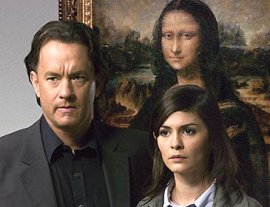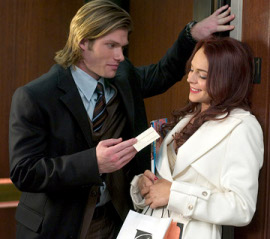 THE DA VINCI CODE
THE DA VINCI CODE
Throughout Ron Howard's The Da Vinci Code - based, of course, on Dan Brown's staggeringly successful novel - Tom Hanks and Audrey Tautou continually find themselves in dimly lit rooms, gloomy cathedrals, and the occasional underground tomb. When the characters finally do venture outdoors, their visibility doesn't much improve, as almost the entire movie takes place at night. And during the film's two-and-a-half-hour running length, deprived of nearly all natural (and even artificial) light, I never craved a nap so badly in my life.
Some directors (David Lynch and Michael Mann spring immediately to mind) know how to make darkness suggestive and electrifying - how to fill the air with dread and threat - and The Da Vinci Code would seem foolproof in regards to providing audiences with good-time-in-the-dark shivers. Brown's Christianity-goosing theories may be specious, but - so long as you don't take them as gospel - they're enjoyably specious, and as laden with murder, self-flagellation, and clandestine meetings as the material is, it seems almost ridiculous that, as a movie experience, The Da Vinci Code is so dull.
But Ron Howard is not, to put it mildly, strongly visual, and The Da Vinci Code needed a strong visual director. (Howard thinks grand but doesn't see grand.) He trots out the expected religious imagery and replays tricks that have worked for him in the past; when Hanks' Robert Langdon deciphers the film's plot-goosing anagrams, the letters glow and reveal themselves like Russell Crowe's math equations in A Beautiful Mind. Yet while Howard's staging is sometimes sharp (a head-on car collision, seen in flashback, provides a brief, scary rush), the movie's relentless murk isn't alive. Dark is simply dark.
Worse, Howard seems to have confused dark with funereal, and a moribund reverence hovers over the project, as if he were directing A Work of Art as opposed to a subversive, gloriously goofy pop entertainment. (The score, by Hans Zimmer, is similarly oppressive.) He treats The Da Vinci Code with a seriousness that borders on pomposity, and this faithfulness to the import of Brown's novel kills the momentum. Even the thrills have no thrill.
The film's soporific qualities, however, extend well beyond the murky visuals; even if the entire movie were shot in broad daylight, Akiva Goldsman's screenplay could still put you to sleep. I have yet to encounter anyone who read Brown's novel who didn't get a kick out of it, and having not read it myself, I won't venture a guess as to what the initiated will make of Goldman's Da Vinci script. Yet surely the material must read better than it plays? There's nothing behind Goldsman's flat, uninspired verbiage - no fervor, no mystery, not even the occasionally clever turn of phrase. Nearly scene for scene, the badinage consists of a declarative sentence, followed by a retort of the "What does that mean?" variety, followed by a lengthy, prosaic explanation, and the sameness of the dialogue rhythms is wearying. Goldsman appears to have striven so hard to fit all of the novel's plot points into 150 minutes that there's no room left for looseness or personality; listening to the film is like sitting through an endless art-history seminar as conducted by the cast of CSI.
A couple of actors, at least, look like they're having fun. Paul Bettany, behind eerie contact lenses, is creepy and oddly empathetic as the malevolent albino, Silas, and Ian McKellen, as scholar Leigh Teabing, chews the scenery with vigor, providing one of those hearty, desiccated-old-bastard numbers that would be a lot more enjoyable if - through the obviousness of Howard's close-ups and Goldsman's punchlines - his snaky charms weren't being shoved down our throats. (He practically has "For Your Consideration ... " stamped on his forehead.) But Tautou, though more authoritative and mature than I've yet seen her, doesn't provide much spark - matters aren't helped by the French star's still-shaky English - and Hanks gives a rare unfocused performance; it makes sense that his symbologist would be baffled by the secretive goings-on around him, but more often than not, it's merely Hanks who seems baffled. (It looks like he's implicitly asking the director, "Is this all you want from me?") Like the rest of the movie's characters - and like those of us in The Da Vinci Code's audience - Hanks is spending far too much time in the dark.
 JUST MY LUCK
JUST MY LUCK
So will I get drummed out of the critics' union for admitting that, if pressed, I actually preferred the innocuous dippiness of Just My Luck to Ron Howard's dour opus?
Don't mistake this sentiment for an actual recommendation, though. In case you don't yet know the plot of Donald Petrie's romantic comedy, let me nutshell it for you: Lindsay Lohan has good luck. Chris Pine has bad luck. They kiss. Then Lohan has bad luck, and Pine has good luck. Poor Lindsay Lohan. (There. A 25-word pitch. Just as Hollywood executives most likely appreciate.)
Although Just My Luck's premise is slightly more clever than I'm making it sound, there really isn't anything here that much deviates from traditional expectations - if you've seen a movie of its type in, say, the last 40 years, you should know exactly what you're in for. (The movie isn't formula so much as baby formula.) En route to the obligatory happy ending, you'll have to endure a lot of tired shtick - Lohan loading the washing machine with too much detergent and such - and some fine performers (Faizon Love, Tovah Feldshuh, Missi Pyle) stuck with too little to do, and there are curlicues here that are more odd than anything; the British pop band McFly performs on-screen with such regularity that, for long stretches, Just My Luck resembles a Sandra Bullock vehicle crossed with This Is Spinal Tap.
The resulting film should be pure tedium, at least for anyone over the age of 12. Yet while its limited charms are purely confectionary, at least it has a few. Petrie stages many of the predictable gags with relish - there's some inventive silliness when Lohan takes a job in a bowling alley - and Chris Pine (who looks like a junior Peter Gallagher with the eyebrows under control) is an agreeable, sweet-natured presence. Best of all, the movie has Lindsay Lohan, and while the actress' tabloid antics may be tiresome, amazingly, the actress herself isn't. She has a natural, easygoing appeal and is a more-than-capable performer, but what I most enjoy about her is her willingness - even eagerness - to be used as a slapstick buffoon; Lohan endures comic humiliations with a game spirit and even grace, and no actress in modern movies takes a better pratfall. Her contributions here aren't quite reason enough to catch Just My Luck; Freaky Friday and Mean Girls make far better use of her talents. But if your only awareness of Lohan comes from what you read in the National Enquirer or Us, it's not a bad way to begin playing catch-up; the people I know who don't care for Lindsay Lohan are, nearly across the board, those who haven't really seen what she can do.










